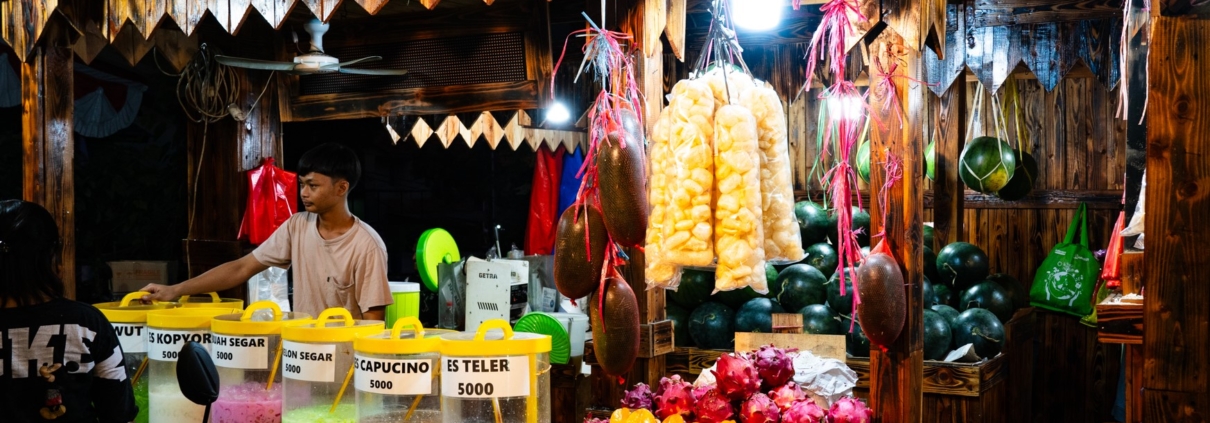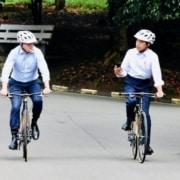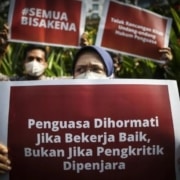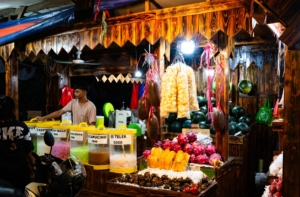
A typical street store (warung) in Jakarta. Photo supplied by Herald van der Linde.
Jakarta is a fabulous city. To many, this statement might sound odd. The city conjures up images of endless traffic jams, immense shopping malls that all sell pretty much the same thing and, of course, floods.
But to me Jakarta is more than the political, economic, and cultural centre of Indonesia. This sprawling metropolis of more than 30 million people is a vibrant, bustling place, brimming with life, an immense labyrinth of small alleys and streets where children still walk to school, vendors sell bakso (meatball soup), and women operate tiny street-side stores stuffed with everything from snacks and noodles to batteries, cigarettes and stationery. There are small barber shops, motor repair shops – most advertising the ability to perform “magic” on any vehicle regardless of condition – badminton courts, and small mosques. Street traders move vast quantities of goods around on motorcycles and handcarts through these intricate kampung (villages).
Once it grows dark, the small shops light up, creating an atmosphere of convivial good cheer. In the warm evenings, I enjoy sitting outside, smoking a kretek cigarette (a habit I am still trying to break) and order sate or nasi goreng from the passing hawkers. The neighbourhood spirit harks back to the days when these kampungs – now absorbed into the broader metropolis – were originally small villages and settlements set apart from the city.
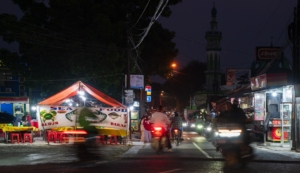
A crowded kampung in Jakarta. Photo supplied by Herald van der Linde.
Jakartans are as diverse as they are friendly. It is difficult to find anyone who is not open for a chat, even with complete strangers. They come from all corners of the sprawling, multilingual Indonesian archipelago, bringing with them their own folklore, languages and dialects, traditions and cuisines. Every Jakartan knows where to get their Aceh noodles, beef rendang from Padang or coto, a soup from Makassar. Jakarta can leave its mark on visitors in many ways – whether by sheer size, outrageous traffic congestion, imposing landmarks, or the variety of its colonial architecture – but its real beauty lies in the kampungs.
However, Jakarta has to face up to formidable challenges. Reading apocalyptic newspaper articles about Jakarta’s floods, its suffocating traffic congestion or how it is slowly sinking into the mud, one might wonder if this city has any future at all. To add insult to injury, the capital will move to Kalimantan. Can Jakarta survive? And how? To answer these questions, some historical perspective is useful.
Dealing with floods (banjir) is nothing new. Thousands of years ago, a network of rivers – among others the Ciliwung – wound their way through the plains, depositing silt below sea level on the coast of the Java Sea, turning it into a fertile, low-lying alluvial plain with soft soil and swamps.
By the fifth century the Tarumanagara kingdom emerged and chiselled messages in stone tell us they were busy digging canals. Over a thousand years later, soon after their arrival, the Dutch discovered that one of their warehouses slowly sank into the mud. Like Tarumanagara, the Dutch solution was to dug canals around Batavia. And when this did not solve the banjir problem, more canals were dug.
Later, exploitation of the lands surrounding Batavia led to serious ecological damage. The rivers clogged up as mills and farms threw their dirt and rubbish into the rivers. In the absence of government projects to deal with these challenges, people took the initiative in their own hands. By the late seventeenth century wealthy landowners and smaller farmers alike got involved removing dirt and large trees from the river.
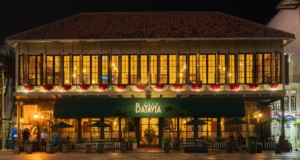
Cafe Batavia continues as a colonial landmark in Jakarta’s old town. Photo supplied by Herald van der Linde.
This did not solve the problem either and Batavia continued to be plagued by floods. Eventually, the Dutch started all over again and moved the capital to what is now Gambir (Weltevreden) in Central Jakarta. That was the first time the capital was moved. New roads and canals were dug and excellent infrastructure was put in place for the rich.
Not so for the poor in the kampungs. To get water, village people used wells to tap underground aquifers. Even today, most Jakartans get their water from such private wells. This continuous extraction of groundwater, exacerbated by the ceaseless construction of large buildings in more recent years, forced the soil to compress. And as the underground aquifers were sucked dry, the city gradually subsided and flooding became even more frequent.
It took the Dutch until the twentieth century to dig a banjir (flood) canal and its only recently that another canal was dug to allow rivers to circumvent the city on the other side. Despite this, modern Jakarta still floods.
So what is the long-term solution?
One option is simply to say goodbye and good riddance and start all over again in another location. The Dutch tried this in Gambir (Weltevreden) and Indonesia is doing it again by moving the capital to Kalimantan. But moving 30 million people is not realistic and history tells us that that is often very costly to the poorer families in the city.
Another option is to provide room for water to move around the city by building more canals and create new lakes. This would turn Jakarta into a city of sparkling blue vistas. This idea is already implemented in Rotterdam. Lakes near the city can flood when a surge of water surge hits the coast while, inside the city, low-lying public squares and football fields collect excess rain.
Before the pandemic hit Jakarta, a series of such development projects had been planned to make the city more livable, including a Rp 571 trillion (US $40.5 billion) “urban regeneration” project. This 10-year plan will also focus on the creation of a better integrated public transit system and the improvement of the city’s clean water and wastewater systems, housing and flood control system.
But whatever approach is taken, part of the solution lies with locals in the kampungs. Small changes by individuals can also make a big difference. Just as in the past, landlords and farmers took the initiative to remove dirt and trees from canals, so changes made today in the kampungs can, in combination, be very important. If one house is designed to be environmentally friendly others can too, and a million such houses will create a greener, cooler city. If one house offers a public space to others, then multiply that decision by a million and … you get the picture.
As in the past, constant flooding, congestion and subsidence has given birth to an awareness amongst residents that something needs to be done. Everybody needs to contribute. And if there is anything Jakarta has in abundance, it is human ingenuity. In the face of adversity, Jakartans tap into a unique brand of quirky humour to make light of even the grimmest of circumstances. Children turn floods into swimming galas, adults go around on jet skis. To get around “three-in-one” traffic regulations (of a minimum of three in each car in the mornings), ‘jockeys’ line the side of streets offering to be passenger for a small fee.
There is still hope for this unruly urban sprawl. Politicians, architects, bankers and engineers must rise to the challenges that the gigantic city faces. More subways, canals, roads and tunnels will be needed. But equally important is support for the many small changes that can take place across the city. Just like collecting recehan (pennies), this can accumulate to something meaningful and valuable.
And that is what will determine the future of this great city.
Herald van der Linde is the author of “Jakarta: History of a Misunderstood City” and “Majapahit: Intrigue, Betrayal and War in Indonesia’s greatest Empire”.


